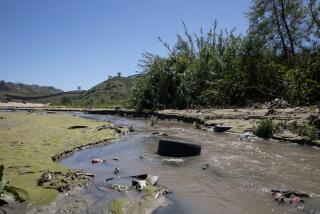Toxic Waste Study Prompts Call for Task Force : Environment: Alarcon reacts to reports that disproportionate number of hazardous sites are in minority communities.
Reacting to a study that shows minorities are more likely than whites to live near hazardous waste treatment plants and dumping centers, Los Angeles City Councilman Richard Alarcon called Wednesday for the formation of a task force to reverse such inequities.
The proposed “environmental justice task force” would try to reduce the number of hazardous sites built in minority communities and would call for measures to lessen the impact of existing sites on those neighborhoods, he said.
“I don’t think, frankly, that many people were surprised with the study but I think it’s time we deal with the issue,” said Alarcon, who represents a district in the northeast San Fernando Valley made up mostly of Latino residents.
The study, by researchers at Occidental College, used computer and geographic satellite techniques to show that minorities in Los Angeles County are three times more likely than whites to live within a half mile of a hazardous waste site.
It examined 82 hazardous waste treatment, storage or disposal facilities registered with the state department of toxics in Los Angeles County and documented the ethnic makeup of the population around the sites.
But Alarcon, who has long fought to close the city-run Lopez Canyon near Lake View Terrace, wants to expand the task force’s focus beyond hazardous waste treatment sites to look at the location of landfills such as Lopez Canyon and other potential sources of toxic hazards, such as oil pipelines.
Alarcon has charged in the past that Lopez Canyon, a 400-acre facility that takes in about 80% of the city’s trash, regularly emits hazardous gas and leaks fluids into the soil.
His district, which he complains has been targeted for potentially hazardous facilities, also has two other operating landfills, dozens of inert and sanitary dumps that have been closed and two sewage dumping sites. In addition, a firm has also proposed installing a pipeline from Santa Barbara to Los Angeles that would pass through portions of Alarcon’s district.
“I want the task force to take a broad brush and look at all obnoxious and potentially environmentally dangerous facilities,” he said.
Alarcon’s motion instructs the city’s Environmental Affairs Department to form a task force and draft a study within 30 days, assessing whether the Occidental College study accurately reflects conditions in the city of Los Angeles. It also instructs the department to plan a conference on the issue within a year.
*
The motion will probably be referred to the council’s Environmental Qualify and Waste Management committee for consideration within the next month. The entire council will probably take up the motion soon after.
Alarcon’s motion was immediately endorsed by five other council members, some of whom said the study confirmed repeated complaints by minorities in Los Angeles.
Minority council members said potentially hazardous facilities and businesses have been located in minority neighborhoods because minorities have in the past had few, if any, representatives in government to voice opposition.
Councilman Mike Hernandez, who is also fighting the proposed pipeline that would cross his East Los Angeles-based district, said that for many years minority communities did not get fair representation because voting districts were gerrymandered to benefit white candidates.
That was not the case in non-minority communities, he said.
“If you talked about putting a pipeline in West L.A., they would fight it,” Hernandez said.
He also blames poor land-use planning that allows high-density housing near industrial businesses.
Councilman Mark Ridley Thomas, who represents parts of South Los Angeles, said the study confirmed what many minority leaders have long been saying.
“It’s a national problem,” he said. “It’s not just a local problem.”
But he added that minorities have begun voicing opposition to potentially hazardous facilities as they have become educated, along with the rest of the nation, on environmental hazards.
In his district, Ridley-Thomas said many residents complain about the noise and fumes generated by recycling centers located near residential neighborhoods.
More to Read
Sign up for Essential California
The most important California stories and recommendations in your inbox every morning.
You may occasionally receive promotional content from the Los Angeles Times.











